 Basketball may have been the first sport to have a shot clock, that is, a time period which an attempt must be made to make a basket. The penalty is to give the other team possession of the ball. Prior to then, a team could, in theory, hold the ball and pass it around for many, many minutes. Indeed, teams did do this, making the game all but unwatchable.
Basketball may have been the first sport to have a shot clock, that is, a time period which an attempt must be made to make a basket. The penalty is to give the other team possession of the ball. Prior to then, a team could, in theory, hold the ball and pass it around for many, many minutes. Indeed, teams did do this, making the game all but unwatchable.
Tennis used to not have a shot clock. They relied on being gentleman. You started the next point in a reasonable amount of time. Then, they decided to add a time limit of around 35 seconds. This was meant to speed up the game, but ironically, had the opposite effect. Ivan Lendl famously dried off his racquet handle, and tried to milk the entire time, in an attempt to slow down the game. At the time, it was legal, but it drove players like Brad Gilbert, who preferred an up-tempo speed, nuts. Eventually, they cut down the time to 25 seconds. Despite this, the rule is rarely enforced. It is considered part of the penalty system (warning, point penalty, ejection).
Announcers frequently criticize players for exceeding the time limit. Nadal and Djokovic used to bounce the balls prior to serve a dozen times or more. Both have worked to restrain how many bounces they use, and so it’s much better than it used to be.
Brad Gilbert has championed the idea of a shot clock like they have in basketball.
There are supposed to be experiments in the Challenger tour to make the penalty of a shot clock a fault (which would only work for the server–presumably a point penalty could be used for receivers) to see how this might work in practice.
There are some issues that complicate a shot clock. What if a player breaks a string and has to get a new racquet? What if a player is challenging a call? What if a player is arguing with an umpire? What if the point that was just played has been amazingly long? What if there is someone in the audience that won’t sit down, or there are other distractions in the audience (someone faints).
One solution to this, and it only addresses some of the problems is having a second clock. Each player is allotted so many minutes per set, say, three minutes. Once they go over, they can dip into this reserve pool, and use it however they wish. When the three minutes runs out, they are out for the set, and the 25 second rule applies once again. This would allow for rest in some long points, and would only apply to the server. The receiver must still be ready when the server is ready, otherwise the server gets to serve regardless of whether the receiver is ready or not.
The penalty, in my mind, should be a fault for serves and point loss for receivers. And I think, even with this additional clock, you’re going to see exceptions which would still require the umpire to halt the shot clock, or at least delay its start (or enforcement) in certain unusual situations, which would then defeat the purpose of having the shot clock.




![[US Open Men’s Final] Can Djokovic beat Nadal in the finals?](https://www.essentialtennis.com/wp-content/uploads/2013/09/20130909djokovic-500x383.jpg)


![[French Open] The tactics of the Djokovic-Nadal semifinals](https://www.essentialtennis.com/wp-content/uploads/2013/06/20130607nole-500x383.jpg)